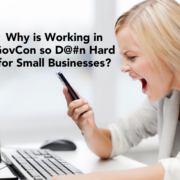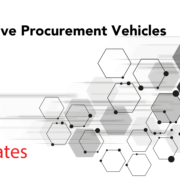-As shared by Meg Kerns
I’m adding to your buzzword-bingo card today. Let’s have a brief chat about OTs, SBIRs, and STTRs. Or Alternative Procurement Vehicles – Other ways of finding work available, especially to businesses specializing in a variety of topics who are working the research, development, and prototyping angle. And chances are, if you’re listening, you fit that niche.
Let’s start with the good ‘ole OTA. Here’s an important note to start. It’s not technically called an OTA – OTA Stands for Other Transaction Authority or the authority associated with other transactions, and when we refer to them they should be called OTs or just Other Transactions. Let’s face it, OTA is more fun to say, and it’s technically understood in normal govcon conversation.
In short- OTs are legally binding instruments that may be used to engage industry and academia for research and development or prototyping activities.
More than what they ARE, OTs are typically defined better as what they are NOT. OTs are not standard procurement contracts, grants, or cooperative agreements. Therefore, they’re not typically subject to FAR regulations YET they are still legal and encouraged.
OTs typically allow for more flexibility, greater speed (in theory), and access to innovative solutions in performing research and prototyping activities. Fun fact: you can also prototype a process that broadens the scope of opportunities as well. On average, and this varies by technology vertical, from white paper to award can take as little as two months in some cases but please note that is NOT the standard – I don’t want to promise a quick turnaround for EVERYONE – this is still the government after all. Though speed has been a happy byproduct of the OT process that is NOT necessarily what it was created to achieve.
Historically, the National Aeronautics and Space Act of 1958 was created by NASA to develop a national space program. In its creation, NASA was granted broad authority to enter into and perform such contracts, leases, cooperative agreements, or other transactions as may be necessary to accomplish its mission. Thus, the OTA was born! At present, I believe 13 agencies have OT authority to date.
Those eligible to receive OT awards are non-traditional defense contractors OR traditional defense contractors who have a non-traditional contractor participating to a significant extent regarding the technology or product. Another caveat is that the traditional contractor can provide a financial or in-kind cost share of at least 1/3. But defining a non-traditional is a conversation better had with a consortia program manager who can better identify the exact specifications per each vertical.
OTs are most commonly run through OT Consortia Management firms or CMFs, like our friends at ATI – Advanced Technology International, who serve as the administrative, educational, and community arms of the OT Consortia model. Through them the opportunities flow, and they take on the responsibilities associated with a CMF.
We recently hosted a govmates institute with a panel on OTs and more where we got to talk to both consortia representatives and business leaders who have experience and success in the OT space. It’s very possible to identify, educate, and introduce the OT opportunity to your customer but they often need some of those proof points and a little convincing that this is a viable, legal, option for R&D work – which I’m happy to say, it is!
Additionally, follow-on work awarded after an OT has been awarded can be sole sourced because technically it was already openly competed.
Now to the SBIRs and STTRs. Or as I like to call it, two ingredients of our govcon alphabet soup. Let’s start with the definitions.
SBIR stands for the Small Business Innovation Research Program, and it is a competitive awards-based program used to encourage small businesses to engage in federal R&D with the potential for commercialization. On the other hand, STTR stands for the Small Business Technology Transfer Program and is a partnership between small businesses and nonprofit research institutions in a formal collaboration (specifically for phases 1 and 2). It’s used to bridge the gap between science and commercialization that results in innovative solutions.
To make it simple, STTRs DO NEED to be backed by a lab or academic foundation through which the research is guided and presented. SBIRs do NOT need to have academic/lab backing, but that doesn’t mean it doesn’t happen. To be considered a small business in these instances the company must be US-owned, there should be 500 employees or less, and their technology needs to be something unique to the space – or at least interesting enough to warrant further research and development.
Let’s get into the phases of these programs and what they mean for competing businesses.
- A Phase-1 portion of an SBIR or STTR is typically about 150 thousand to 250 thousand contracts that facilitate concept development and the proof of concept. This is where you get to discover exactly HOW your solution is to work and what it’s going to do – in-depth – to provide a solution to the government’s problem
- A Phase-2 contract – what we ALL want to achieve; funding is based on the results achieved in Phase I and the scientific and technical merit and commercial potential of the project proposed in Phase II. Typically, only Phase I awardees are eligible for a Phase II award. SBIR/STTR Phase II awards are generally under 1 million dollars for 2 years. This is where you get to develop the actual product or solution for use.
- Phase 3 – The objective of Phase III, is for the small business to pursue commercialization objectives resulting from the Phase I/II R/R&D activities. This is the “you’ve created it, now go forth and conquer phase”, The SBIR/STTR programs do not fund Phase III. At some Federal agencies, Phase III may involve follow-on non-SBIR/STTR funded R&D or production contracts for products, processes, or services intended for use by the Government.
Furthermore, certain agencies have SBIR only or BOTH STTR/SBIR opportunities, and they are as follows:
SBIR only would be USDA, NIST, NOAA, Department of Education, Department of Homeland Security, Department of Transportation, and the Environmental Protection Agency.
Those with SBIR AND STTR opportunities would include NASA, The National Science Foundation, the Department of Energy, the DoD, and the Department of Health and Human Services.
To put it simply, OTs, SBIRs, and STTRs are alternate opportunities for small innovative businesses to get off the ground with really interesting technology and solutions that the government DOES need. They just don’t know if or how it exists. We say it all the time around here, change is driven by change makers, and those change makers in govcon are the agile, innovative, small businesses with the drive and vision to make things happen.
In summary, here are a few things to take away:
- If you’re interested in the SBIR/STTR programs – make someone in your organization the designated SBIR/STTR expert – it does take research and effort to learn, develop, and prepare for these opportunities but once awarded – you have even more potential opportunity for growth.
- While you don’t HAVE to join a consortium to be eligible for OT opportunities – the community, resources, and management of such opportunities can not be ignored. Choosing a consortium that works best for your specific technology vertical can not be ignored.
- Finally, do your research! You won’t know what opportunities exist if you follow behind the pack. Go to events, seek discussions with those who have been there, learn where YOUR business fits best, and go after those opportunities.
If you have other questions regarding OTs, SBIRs, STTRs, or otherwise as this was a brief introduction that hopefully helped to get the cogs turning, I’d be happy to have a more in-depth conversation with you about the models or nuances or point you in the direction of someone who has been there for more information.
If you’re NOT already part of a consortium and want more information you can always email the govmates team at ati@govmates.com, and we’ll point you in the right direction of a human who can answer your technology-vertical-specific consortia questions.
You’ve got interesting technology? You’ve got options.













